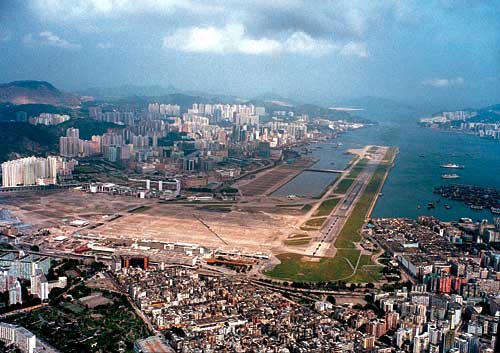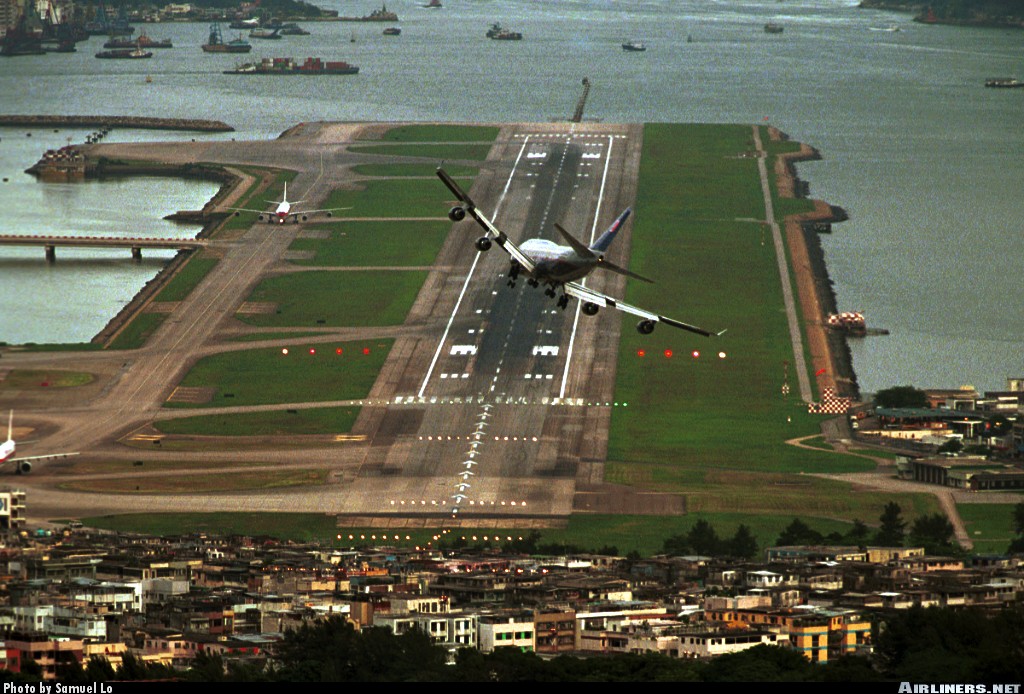Have
you ever flown into Hong Kong before 1998? If so, you probably never forgot
your arrival. Before the current airport in Hong Kong took over in 1998, Hong
Kong’s Kai Tak airport was the main airport for all arriving and departing
aircraft. The airport had a runway of over 10 000 feet so it was perfectly
capable to handling large long haul aircraft, although, large aircraft had a
rather hard time getting down to the runway.
If
you’ve been on an airplane before you probably know how the whole jig works.
There is a system called an instrument landing system (ILS) which includes a
VOR beacon and a glideslope. When the pilot turns his aircraft to face the
runway, he captures the ILS signals and the aircraft flies itself down to the
runway, until the pilot decides to take over manual control by disengaging the
autopilot. This is a standard procedure at major airports all around the world,
although, at some specialty airports, this procedure does not exist. The
absence of an ILS system usually means that one cannot be physically
implemented into the airport because of surrounding terrain. That was the case
at Hong Kong’s Kai Tak airport.
 Hong
Kong’s downtown core was basically built around Kai Tak. Eventually, the entire
airport was surrounded by high rise office buildings and residential areas.
This doesn’t pose as much of a problem as the mountain does. Kai Tak had two
runways, runway 13 and runway 31. You may be confused if you look at a diagram
of the airport because there only seems to be one runway. Runways 13 and 31 are
the same runway, but runway 13 is on one end and runway 31 is on the other.
Runway 13’s straight in approach is obstructed by mountains which makes landing
on this runway very difficult. One may say “why not land on the other runway?”,
but this is usually impossible because departing aircraft cannot take off
towards the mountains so aircraft must both land and take off on runway 13.
Hong
Kong’s downtown core was basically built around Kai Tak. Eventually, the entire
airport was surrounded by high rise office buildings and residential areas.
This doesn’t pose as much of a problem as the mountain does. Kai Tak had two
runways, runway 13 and runway 31. You may be confused if you look at a diagram
of the airport because there only seems to be one runway. Runways 13 and 31 are
the same runway, but runway 13 is on one end and runway 31 is on the other.
Runway 13’s straight in approach is obstructed by mountains which makes landing
on this runway very difficult. One may say “why not land on the other runway?”,
but this is usually impossible because departing aircraft cannot take off
towards the mountains so aircraft must both land and take off on runway 13.
So,
in the 1970’s one man came up with a radical idea. He suggested that an ILS
system could be implemented for aid the pilots on approach into the airport,
but not line them up with the runway. The system worked as follows. The pilot
would capture an ILS signal which would points directly at the mountain. Then,
the pilot would disconnect the autopilot when he sees a brightly lit
checkerboard and make a 47 degree right turn to line up with the runway. Oh, I
forgot to mention that the winds on the airfield were usually a right crosswind
making it even more difficult for the pilot to line his plane up with the
runway.
 So,
now that we all know about the “checkerboard approach”, it’s time to ask the
question, was it too dangerous? The topic has been debated for a while but the
main answer is no. The approach was in no way dangerous. It was a complicated
approach in which pilots had to spend hours training in the simulator, but it
was not dangerous.
So,
now that we all know about the “checkerboard approach”, it’s time to ask the
question, was it too dangerous? The topic has been debated for a while but the
main answer is no. The approach was in no way dangerous. It was a complicated
approach in which pilots had to spend hours training in the simulator, but it
was not dangerous.
In
fact there was only one accident concerning the approach, which was a plane
overshooting the runway and ending up in the ocean. If there wasn’t more than
one accident, it says to me that the approach could not have been dangerous. If
this was back in the 50’s, I may have said it was dangerous for one reason.
Flight Simulation has reached new heights in the past 50 years and now every
pilot must train in sophisticated simulators before they even get to touch the
real aircraft. Since the simulator technology existed when the approach was
made, pilots got the hands on experience of the flying the approach
realistically before they even tried their hand at the real thing.
In
addition, many people think that the airport was closed mainly because the
approach was too dangerous but this is not the case. Kai Tak airport was old
and very small. There was simply too much traffic in such a small airport so
they had to build a larger airport on a manmade island. No approach is
dangerous, as long as the pilots have the proper training to make the approach
safely. One cannot fly into Kai Tak anymore since its closure in 1998, but the
checkerboard approach will always be remembered as the beast for pilots to
tame.


No comments:
Post a Comment